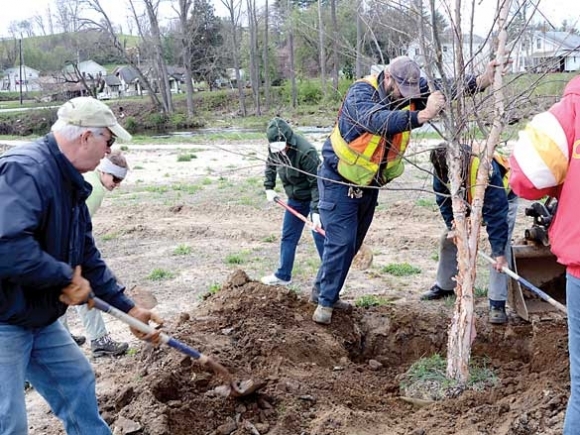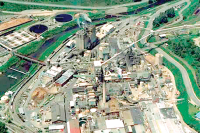Clyde river park gets a facelift: Plans call for extensive tree planting, walking paths and river access

On the chilly, windy afternoon of April 7, a crew of seven people gathered to install a passel of hefty red maple and river birch saplings into their new home, River’s Edge Park in Clyde. With the help of shovels and a mini-dozer it took just 2 hours to plant the 13 trees, but the work is far from over. Using mostly grant funds and volunteer labor, the town of Clyde intends to eventually plant the riverside park with thousands of trees and shrubs.
“The main issue is erosion happening along the riverbank and in the park itself,” said Eric Romaniszyn, director of Haywood Waterways Association. “Of course we believe that trees and shrubs are the best solutions for that.”
The park, located along the Pigeon River on Thickety Road not far from downtown Clyde, is in a historically flood-prone area — which, actually, is the reason that it’s a park at all. When hurricane-induced flooding swept the area in 2004, the water rose and homes were destroyed. A government program allowed the town to buy out the property where 4.5-acre River’s Edge Park sits, and in 2013 the park was created to provide the area with flood storage and green space.
“It is doing exactly what it was designed to do,” said Clyde Town Administrator Joy Garland. “With the rain events we’ve had historically, the water would get out on Thickety Road first, so this is acting as a holding area where it can slowly release instead of flooding that road.”
However, the park’s function isn’t perfect yet, and that’s where the tree planting comes in.
“The first year the park was put together, we had about 13 rain episodes and it has washed great big gullies in it because we have not been able to get any vegetation to grow,” Garland said.
Related Items
The water was undermining some of the concrete sidewalks laid out through the park, and it was carrying sediment into the river. The issue prompted Haywood Waterways to apply for a grant from the Pigeon River Fund to come up with an overall master plan for the park, which Asheville-based Equinox Environmental completed in March 2016.
The plan focuses mainly on planting trees and shrubs throughout the property. A revegetation plan calls for nearly 800 larger trees and more than 3,000 small seedlings to be planted, as well as shrubs and herbaceous plants for a milkweed garden. The idea is that the resulting root mass entering the soil will hold it in place, protecting it from washing away when floods come and slowing the water’s escape onto the road and nearby properties. Some of the work had already begun before last week’s tree planting, with volunteers from Haywood Community College planting trees, removing invasive species and cleaning up trash earlier this spring.
“It will look like a floodplain forest,” Romaniszyn said. “The trees, along with holding the land together in the riverbank, they also serve to slow floodwaters. So the slower you can get floodwaters to go, the more it protects downstream landowners.”
The revegetation work will be funded through a $44,000 grant from the N.C. Community Conservation Assistance Program, secured by the Haywood Soil & Water Conservation District, and $44,000 more from a Pigeon River Fund grant and marketing funds. The town of Clyde will also contribute about $10,000. Other partners include HCC, Haywood County Schools and Southwestern N.C. Resources Conservation and Development Council.
“It’s a great collaboration of efforts,” Garland said.
Debbie Wilson, one of seven volunteers to come help with the tree planting last week, concurred.
“I think it’s a great location,” Wilson said. “It’s handy for residents. I’m a cyclist and I do bike some on Thickety, so I stop here and enjoy the park.”
The park will be more than just a forest when the plan is implemented. Already, a circuit of concrete walkways encircles it, and the park includes two playgrounds, a picnic shelter and a newly completed outdoor environmental learning center. With Clyde Elementary, Haywood Community College and Central Haywood High School all in the immediate vicinity, hopes are high the learning center will get plenty of use.
The portion of the walkway closest to the river will be converted from concrete to gravel, as the floodwaters have steadily eaten away at the ground underneath that portion of concrete, but the rest of the infrastructure will remain. An open space will be maintained near the picnic shelter, and future plans call for a fishing pier and boating access. Those improvements will further enhance what is already a well-loved community resource, Garland said.
“A lot of folks are out here walking in the mornings and in the evenings after work,” she said. “They’ve really enjoyed it.”
As with any spot in a floodplain, there’s always the chance that some future downpour will frustrate the best-laid plans of mice and men. When the park was built in 2013, about 10 feet of soil was moved so that the site could act as flood storage. This change in gradient could, over time, encourage the Pigeon River’s path to shift to a more direct downhill gradient.
“The timeline for this process is uncertain and will depend largely on the frequency and magnitude of future flood events,” Equinox’s assessment reads. “This could take years or even decades for the process to be completed, or it could occur dramatically in one extreme event.”
Planting the trees should help stabilize things, Romaniszyn said. Of the three options Equinox laid out — revegetation, river realignment and terrace construction — revegetation is the most inexpensive and easy-to-implement approach, though it’s possible that a full riverbank stabilization could happen in the future.
“It all depends on the level of floodwater,” he said. “If we have a 2004 flood happen again, that could realign anything. But with the trees in place, that should minimize it.”
It’s natural for streams in a valley to meander back and forth over a period of centuries or millennia. But both Romaniszyn and Garland are hopeful as to the effect the newly planted trees will have and the value the forested floodplain of the future will hold for recreation and water quality alike.
“We’re really excited,” Garland said.









